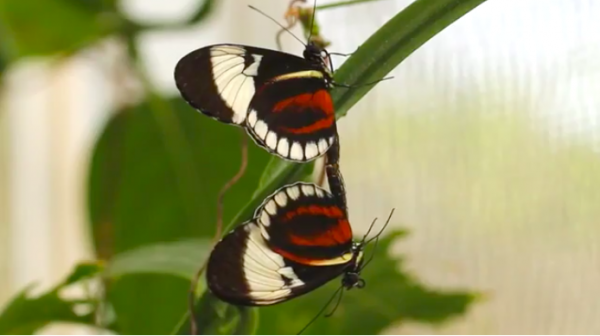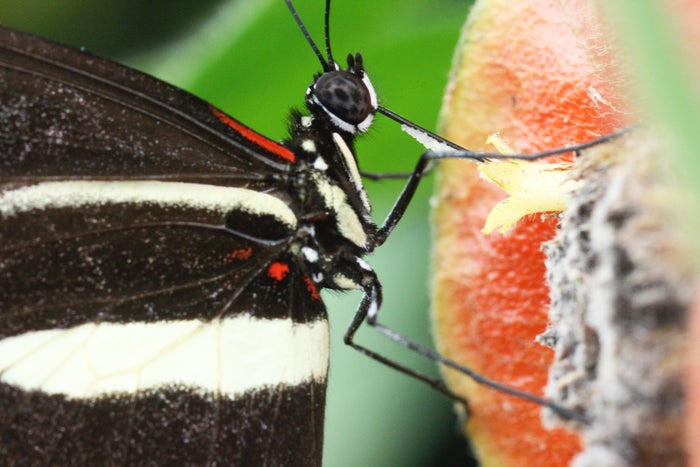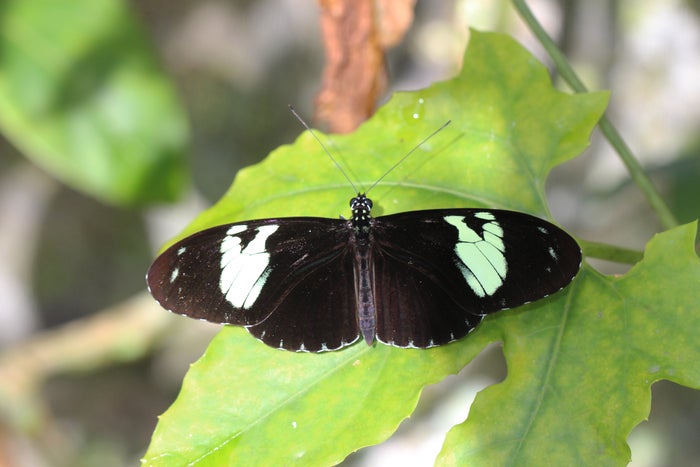Chris Jiggins, professor of evolutionary biology at the University of Cambridge stands at the opening of an Andean forest, waving a little red cloth. After a few seconds, several brightly colored butterflies swoop from above, fluttering around restlessly. The insects—males of the Heliconius melpomene butterfly species that lives on the sides of the Andean Mountains in Colombia—think they have spotted a mate. For them, Jiggins’s cloth resembles the bright red spots on the wings of a female butterfly.
A varied group of over 40 different species, the Heliconians boast a wide range of colors and designs on their wings. Some have black wings adorned with red splotches, some feature oblong white spots, and others sport intricate black and orange filigree. Inspired by their elegant designs, nineteenth century biologist and Sir Alister Hardy once wrote, “it’s likely that there are no finer galleries of abstract art than the cabinet drawers of the tropical butterfly collector.”
Complex and diverse, Heliconian’s wings patterns have drawn the attention of artists and scientists alike. And yet, each distinct species maintains its own unique pattern through generations. Scientists always wondered exactly how the species manage to preserve and maintain these patterns—and don’t cross-breed with each other.
One obvious reason is that Heliconian males are very picky when it comes to choosing their mates. A male will only woo a female butterfly that looks like him—meaning that she has the same color patterns as him. That’s why the red-spotted species react to Jiggins’s red cloth. Scientists knew that this specific reproductive trait drove the butterflies’ speciation, but the exact genetic basis governing their mate selection was unclear until recently.
One thing that’s clear is that for Heliconians the beauty is definitely in the eyes of the beholder. Unlike many other insect species that rely primarily on chemical cues or vibrational signals such as specific buzzing frequencies used by some mosquitoes to find mates, Heliconians use vision. They can spot colors that resemble their own from 30 meters away, Jiggins says. Moreover, unlike humans, all Heliconians can see ultraviolet light, which means that they may actually perceive their wing design patterns as more elaborate and picturesque—something that we cannot discern. Jiggins says that they have two ultraviolet detectors in their eyes and thus can see more than one type of UV light.
After the Heliconian pairs find each other by sight, courtship ensues. The males flutter around and over the females. As they do so, they produce certain chemicals in the scales of their wings that the females find attractive. Essentially, the male butterflies have to smell right, Jiggins says; if they don’t, the females will ignore them. If the courtship is successful, the two will mate—and stay copulated for several hours. Sometimes they fly together from plant to plant with the male pulling the female along. “In some cases they’ll stay like that for a day,” Jiggins says. “Sometimes you can just see them flying by together.”
There’s a reason why the little butterflies have such a long copulation. As they mate, the male transfers a large nutritious capsule called a spermatophore into the female. The capsule “contains proteins and amino acids to produce eggs,” says Richard Merrill who studies behavior and speciation at the Ludwig-Maximilians-Universität in Munich. “We refer to it as a nuptial gift.” But there’s something else passed in the capsule too—a few droplets of poison. The toxic chemicals do not hurt the female though. On the contrary, she puts them to good use—protecting her eggs from predators, Jiggins says. The Heliconians’ affair with poisons, namely with cyanide, starts at a very early age.
The Cyanide in the Sugar
In fact, Heliconians’ bright-colored wings serve a dual purpose. In addition to attracting mates, they also act as a warning sign to predators. The butterflies evolved to synthesize their own version of cyanide, a compound called cyanogenic glycoside—essentially a sugar molecule with a cyanide “extension” of a carbon-and-hydrogen atom duo attached to it.
When caught by a bird, the butterflies release a specific enzyme that breaks down cyanogenic glycoside, freeing up the unpalatable carbon-hydrogen toxin, which makes the captors spit out the prey. The amount of toxin is too small to kill or harm the birds, but it teaches them an important lesson: The creatures with those bright colored patterns on their wings taste bad and shouldn’t be hunted. This concept, known as aposematism, is a good defense method, researchers say. Evolutionarily it doesn’t make sense to kill your predators, but it does to train them to leave you alone.
Unlike certain palatable species that mimic the appearance of poisonous ones to trick predators, all Heliconian varieties stay true to their warning messages. They are all distasteful, Merrill explains, so by using the brightly colored wing patterns they essentially “team up” in educating their predators. That’s why they are called the Müllerian mimics, named after Fritz Müller’s mathematical model postulating that if a predator attacks a certain number of prey before learning to associate a color pattern with bad taste, then the prey species benefits from having similar color pattern since this number would then be shared between them.
The Heliconians are also different from other butterflies in their communal roosting behavior. They spend the night together, congregating more like a flock of birds than butterflies, which may be another type of predator-avoiding behavior. A large assemblage of conspicuous, unpalatable prey likely communicates a more effective repelling signal.
When females receive spermatophores loaded with toxic chemicals, they use them to make their eggs distasteful as well. Then they proceed to lay the eggs, about five to eight a day, for several months, totaling potentially several thousand offspring. The larvae feed on leaves, consuming and synthesizing more toxic chemicals from the plant material—until they transform into butterflies. A lifespan of a typical Heliconian is about eight months, pretty long for a butterfly, Jiggins says. During that time, most Heliconians mate only once, although some manage more, especially males.

Why Heliconian Opposites Don’t Attract
In earlier work, Jiggins and other scientists described how dramatic the effects of the interplay between mimicry and mate choice can be. They crossed Heliconius melpomene butterflies with H. cydno ones, and bred a hybrid that exhibited the wing pattern of a wild species Heliconius heurippa. The hybrid preferred individuals with its own wing pattern to those bearing the different wing patterns of the parent species.
The behavior seemed rooted in genetics but the exact causes weren’t yet known. Now that the sequencing techniques have come of age, Jiggins, Merrill, and their colleagues traced the roots of Heliconian’s mate selection to their genome.
They found that there are three areas in the genome that control mate selection behavior. One of them, which controls the coloration of the wings, is also responsible for defining a sexual preference for those same wing patterns. “There’s a specific gene called ‘optix’ that controls the red patch on the wing,” explains Jiggins. When it’s turned on, the butterflies’ wings get the splash of red—and the males look for that exact red in their partners. It appears that the region around that optics gene also plays a role in males’ preference for mates.
It’s almost as if a specific part of the genome is resistant to change. “That’s how speciation happens,” Jiggins explains. “Having one area of the genome that causes a butterfly to prefer mating with its own kind makes speciation more likely.”
Once a Week
This also explains why hybrids are so rare and why species manage to retain their distinct patterns over long time periods, Merrill adds. “There is a strong genetic preference for similar partners which mostly stops inter-species breeding,” he says. The secret to the butterflies’ distinct design patterns is rooted deep in their genes. “This genetic structure promotes long-term evolution of new species by reducing intermixing with others.”
What shades do females prefer in their partners? That’s a million-dollar question. Because they aren’t as active as the males, it’s hard to tell what color-preferences they have. Perhaps one day the team will zero-in on that gene too.















